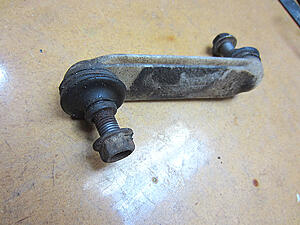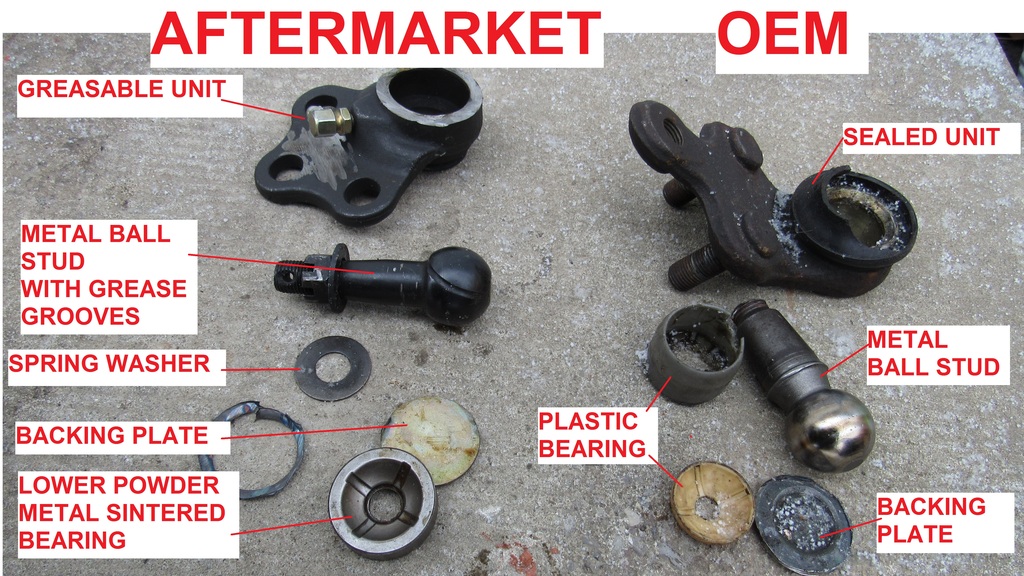What's inside a ball joint: OEM vs Aftermarket
#2
Lexus Champion
Nice video. I will have to disagree on the longevity aspect of the OEM parts that use the metal/nylon setup. In my experience they last the longest I think it's because the nylon deforms enough to slow down wear versus a rigid metal on metal contact. Toyota used to use all nylon (or whatever type of plastic) rear sway bar links except the ball and stud/nut portion those were by far the best they basically never wore out. And didn't rust.
And of course as you pointed out the tolerances of the OEM parts are probably much better and consistent.
And of course as you pointed out the tolerances of the OEM parts are probably much better and consistent.
#3
Lexus Champion
Thread Starter
The plastic bearing does deform and have some give to it. The metal design has a spring washer to provide that give.
OEM ball studs are made of a much higher quality metal, with a much better finish on them to prevent rusting. The aftermarket ones typically use a phosphate or oxide coating, which don't fair as well. Anti-seize is your friend with those.
In the end, you pay more for OEM, you get more, but to what extent is that worth over double the price of an aftermarket ball joint? Of course, to a shop or mechanic putting it on the vehicle for a customer, the more cost effective the solution the better, as long as the car gets out of the shop and the customer is happy.
One thing I do appreciate with aftermarket chassis parts is they sometimes they try to add external hex/ wrench flats on the ball studs, instead of those stupid internal hex designs that often strip out.
OEM ball studs are made of a much higher quality metal, with a much better finish on them to prevent rusting. The aftermarket ones typically use a phosphate or oxide coating, which don't fair as well. Anti-seize is your friend with those.
In the end, you pay more for OEM, you get more, but to what extent is that worth over double the price of an aftermarket ball joint? Of course, to a shop or mechanic putting it on the vehicle for a customer, the more cost effective the solution the better, as long as the car gets out of the shop and the customer is happy.
One thing I do appreciate with aftermarket chassis parts is they sometimes they try to add external hex/ wrench flats on the ball studs, instead of those stupid internal hex designs that often strip out.
#4
Lead Lap
iTrader: (1)
Love this engineering gear head stuff. I learned a ton from this short video and I appreciate you sharing even more info in this thread. Think about adding this sort info to future videos. You did a fantastic job on explaining all the intricate details of each component.
My only constructive feedback is that I felt the conclusion was biased towards the aftermarket part. I feel like there is a reason OEMs use certain designs on such a large scale, which in turn benefit the consumer in the long run. I would have liked to see a deeper explanation of benefits of the sealed design.
Again, great job on the content and keep this sort of stuff coming!
My only constructive feedback is that I felt the conclusion was biased towards the aftermarket part. I feel like there is a reason OEMs use certain designs on such a large scale, which in turn benefit the consumer in the long run. I would have liked to see a deeper explanation of benefits of the sealed design.
Again, great job on the content and keep this sort of stuff coming!
#5
Lexus Champion
The internal hex design is awful, I guess they made it just good enough for assembly nothing more. On aftermarket ball joints, tie rod ends and the like I haven't found good ones yet none of them lasted. That doesn't mean there are not good ones out there, but how to know?
Here's a rear link Toyota used on some 80's and early 90's models the whole thing is plastic except the ball portion these never wear out. This one is still stiff to move, another bonus is the middle portion is much more rigid versus the metal ones. Any idea what type of grease Toyota used on these? It's a dark yellow-ish grease quite thin I can't seem to find anything like it.

Here's a rear link Toyota used on some 80's and early 90's models the whole thing is plastic except the ball portion these never wear out. This one is still stiff to move, another bonus is the middle portion is much more rigid versus the metal ones. Any idea what type of grease Toyota used on these? It's a dark yellow-ish grease quite thin I can't seem to find anything like it.

#6
Yellowish grease? One of the Honda CV grease was yellow, not sure if inner or outer. It could also be one of the grades in Shin-Etsu brand. It could also be Silglyde. The clear grease turns yellowish over time and air exposure.
#7
Lexus Champion
Thread Starter
My only constructive feedback is that I felt the conclusion was biased towards the aftermarket part. I feel like there is a reason OEMs use certain designs on such a large scale, which in turn benefit the consumer in the long run. I would have liked to see a deeper explanation of benefits of the sealed design.
OEM's use plastic bearings because they are cheaper, lighter (CAFE standards), have a reasonable lifetime past the warranty (intended design life) and transmit less NVH. They also don't require constant servicing (like everything else now a days, its moving toward a disposable, maintenance-free design and labor is expensive).
One downside to plastic bearings is they're more prone to temperature fluctuations - too cold and they get brittle, but more commonly with an aluminum knuckle and control arm acting like a giant heat sink, the heat of the brakes can cause them to melt and deform.
When comparing the two the bottom line really comes down to the cost. If you can get a part that will fit, function and last just as long or even longer than OEM for half or one third of the price, wouldn't that be what 80-90% of aftermarket customers need?
Trending Topics
#8
Just went through the video. It was good. Previously I just looked at the pic. But I agree about the sealed vs zerk benefits. OEM is only sealed while aftermarket offers both sealed and with zerks. My decision on either type is normally based on who owns the car (parents, siblings, etc) and what is cost-effective for them in the long run. If I do most of the work all the time for them, then zerk is ok, if not sealed might be better choice, either aftermarket or oem. If I put a grease type and they never get it greased, it will go out fast.
Thread
Thread Starter
Forum
Replies
Last Post
kenkaniff
Suspension and Brakes
33
04-20-08 09:48 PM



